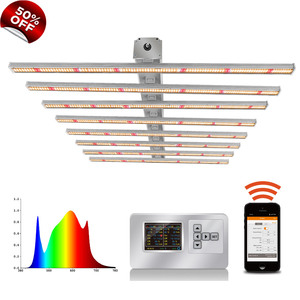Giới thiệu về đèn led hoa growlights
Alibaba.com giới thiệu mạnh mẽ và hiệu quả. đèn led hoa growlights vượt trội về mặt công nghệ và lý tưởng cho tất cả các loại thảm thực vật trong nhà. Những mạnh mẽ và toàn phổ. đèn led hoa growlights được sử dụng trong hệ thống thủy canh, các hệ thống thực vật trong nhà khác và cũng để bắt đầu gieo hạt hiệu quả hơn. Các sản phẩm này được cung cấp với tuổi thọ tối ưu hàng nghìn giờ và được trang bị đầu nối chống thấm nước tự khóa. Mua những thứ này. đèn led hoa growlights từ các nhà cung cấp hàng đầu trên trang web để có những ưu đãi và giá hấp dẫn đáng kinh ngạc.
Nâng cao. đèn led hoa growlights được cấp nguồn bằng đèn LED sáng và mạnh giúp phân tán ánh sáng đồng đều để hỗ trợ cây trồng phát triển tối ưu. Những nông nghiệp hiệu quả. đèn led hoa growlights nhỏ gọn, có thể gập lại và dễ dàng cài đặt ở mọi loại không gian. Người cứng cáp và thành thạo. Thân đèn led hoa growlights được làm bằng nhôm, thép không gỉ, mang lại độ bền tối đa và là thiết bị nhà kính lý tưởng. Những sản phẩm này hoàn hảo cho cả những người yêu thích và chủ dự án thương mại do tính linh hoạt của chúng.
Alibaba.com có một bộ sưu tập đa dạng. đèn led hoa growlights có hình dạng, kích thước, hiệu quả, tính năng và công suất nguồn riêng biệt. Những cái này. đèn led hoa growlights được bảo vệ IP66 và tạo điều kiện cho các tùy chọn làm mờ. Bạn cũng có thể đi cho. đèn led hoa growlights đi kèm với các mô hình và thiết kế tiết kiệm không gian với các tùy chọn có thể gập lại 180 độ. Các sản phẩm này có thể hoạt động ở các nhiệt độ khác nhau và bao gồm thời gian bảo hành dài.
Khám phá các phạm vi khác nhau của. đèn led hoa growlights tại Alibaba.com và chọn những sản phẩm tốt nhất theo yêu cầu và ngân sách của bạn. Bạn có thể đặt hàng OEM và đóng gói tùy chỉnh khi đặt hàng với số lượng lớn. Các sản phẩm này được chứng nhận CE, ISO, ROHS, ETL, CB.














